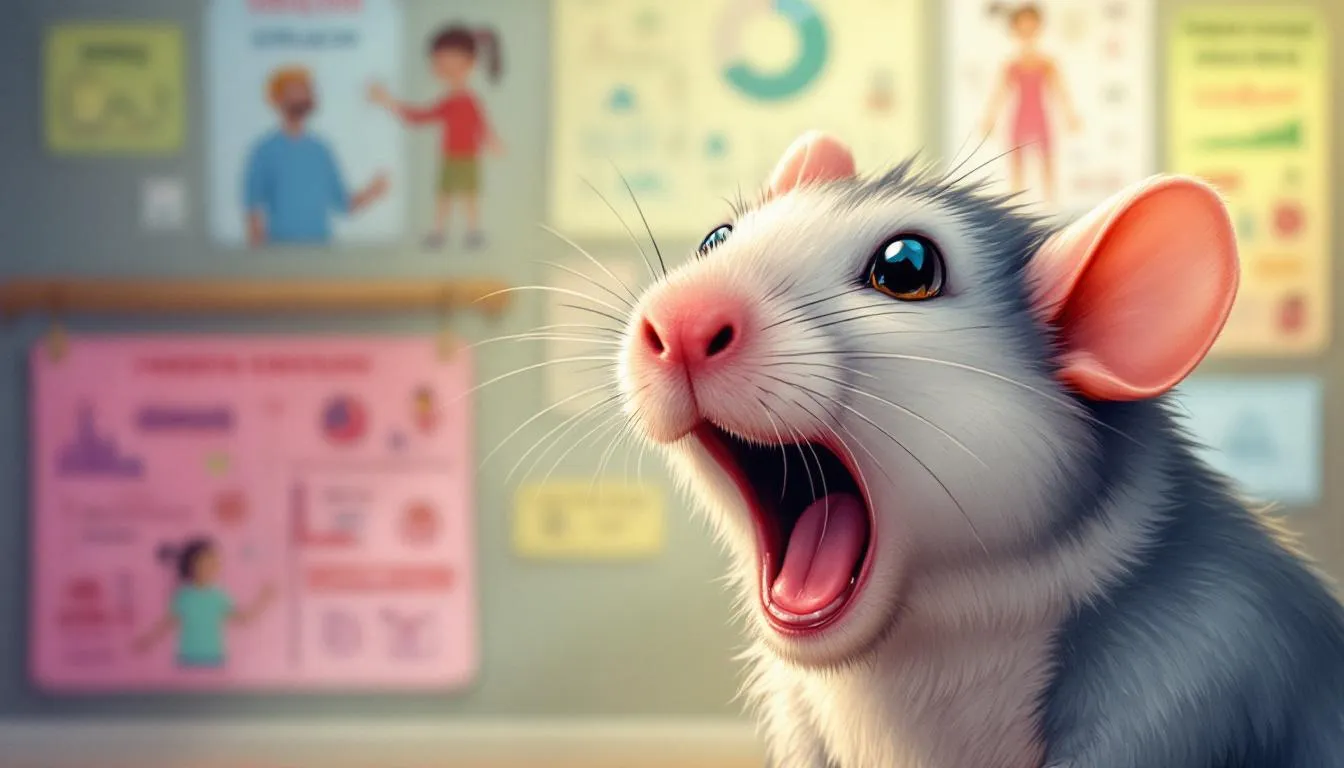Mouse Infestation

Top Rat Diseases: Identification, Prevention, and Treatment
Do you own rats and worry about their health? Rats can suffer from various diseases, including infections, parasites, and respiratory issues. This article will discuss the most common rat diseases, their symptoms, and how to prevent and treat them. Stay informed to keep your rats healthy and happy.
Key Takeaways
Rats are susceptible to various diseases, including parvovirus, rat bite fever, and chronic respiratory disease, which require careful management and preventive measures.
Digestive disorders, bacterial infections, and external parasites such as mites and lice can significantly affect rat health, highlighting the importance of sanitation and regular veterinary check-ups.
Zoonotic diseases from rats, including leptospirosis and rat bite fever, as well as many diseases that pose health risks to humans, necessitate effective pest control and hygiene practices to minimize exposure.
Common Rat Diseases

Rats are affected by numerous diseases, which can range from infections and parasites to cancers. Rats carry a variety of pathogens that can affect both themselves and other animals. One such disease is parvovirus, a highly contagious virus that can lead to:
Small litters
Stillborn pups
Infertility
Fatal hemorrhages
The absence of treatment for parvovirus makes prevention and disinfection of the cage imperative.
Another notable disease is rat bite fever, a disease caused by bacteria like Streptobacillus moniliformis and Spirillum minus, which presents symptoms such as fever, headache, and swollen lymph nodes. This condition is classified as a bacterial disease.
Routine veterinary check-ups play a key role in detecting health issues early, improving the likelihood of effective treatment. Understanding these common diseases and their symptoms is important for all owners of pet rodents, enabling them to manage their pet’s health better and promote a longer, healthier life.
Digestive System Disorders in Rats
Rats commonly experience digestive system disorders. These issues are often triggered by intestinal parasites and bacterial infections. These disorders can severely impact a rat’s health, leading to symptoms such as diarrhea, weight loss, and dehydration.
The dwarf tapeworm, although relatively rare in rats, can cause digestive symptoms such as diarrhea and weight loss during heavy infestations.
Recognizing the causes and symptoms of these disorders is vital for effective prevention and treatment.
Bacterial Infections
Bacterial infections like salmonellosis, caused by salmonella bacteria from contaminated food, water, or bedding, are common in rats. Symptoms may consist of a distended abdomen and diarrhea. Other signs include dehydration, weight loss, a rough hair coat, and in severe cases, sudden death. There is no specific treatment for salmonellosis, making prevention through isolation of infected rats and sanitation of their cage critical.
Preventing bacterial infections also involves maintaining a clean and stress-free environment, especially for pregnant females and infant rats who are at higher risk. These prevention measures can significantly reduce bacterial diseases in rat communities.
Intestinal Parasites
Intestinal parasites like pinworms and tapeworms are another common issue in rats. A heavy infection of pinworms can cause diarrhea due to intestinal inflammation, and the presence of worms or their eggs in feces or around the anus confirms the diagnosis. Tapeworm infections, on the other hand, lead to symptoms such as diarrhea and weight loss, and are diagnosed by identifying tapeworm eggs in feces.
Treating these infections requires:
Appropriate drugs prescribed by a veterinarian.
Stress management, since stress can worsen these infections, especially in younger rats.
Regular monitoring and prompt treatment to help keep these parasites under control.
Respiratory Problems in Rats

Respiratory problems are a significant concern for rats, often leading to severe health issues. Chronic respiratory disease and viral infections like sialodacryoadenitis are common, and knowing their causes, symptoms, and treatment options is essential for maintaining respiratory health.
Hantavirus pulmonary syndrome is a severe respiratory disease caused by hantavirus infection. Hantavirus infections are transmitted primarily through exposure to infected rodents or their droppings. These infections can progress rapidly and have serious health consequences, making prevention and awareness of risk factors crucial for both humans and animals.
Chronic Respiratory Disease
Chronic respiratory disease in rats is primarily caused by bacterial infections, with Mycoplasma being a major agent. Symptoms include:
Sneezing
Sniffling
Labored breathing
Lethargy
Weight loss Environmental factors such as poor sanitation and inhaled irritants can exacerbate the condition, potentially leading to pulmonary syndrome.
Managing chronic respiratory disease involves enhancing living conditions and minimizing environmental stressors. Even with the best care, rats with this condition rarely live longer than two years. Early detection and intervention help manage symptoms and improve the quality of life.
Sialodacryoadenitis
Sialodacryoadenitis is a viral condition that affects the salivary glands, causing severe disease symptoms including inflammation and eye discharge. Recovery from this virus typically spans two to three weeks, but supportive care is essential to aid the recovery process.
Recognizing the symptoms and providing appropriate care can aid the recovery of rats affected by sialodacryoadenitis. Keeping a clean and stress-free environment helps prevent the spread of this viral condition.
Skin and External Parasite Issues
Skin and external parasite issues, such as fleas, mites, and lice, are common in rats. These parasites can cause significant discomfort and health issues if not properly managed.
Infested rats can spread parasites to other animals in the same environment, increasing the risk of infestation among pets living together.
Prompt identification and treatment of these infestations are crucial for maintaining the skin health of rats.
Mites and Lice
Mite infestations in rats are characterized by intense itching and scabbing on the shoulders, neck, and face. Lice infestations cause similar symptoms along with restlessness, weakness, and anemia. Diagnosis involves identifying the parasites or their eggs in hair and skin samples. Rat lice are species-specific and do not typically infest human beings.
Treating mite infestations generally involves medication administered orally or applied to the skin. Regular cleaning and disinfecting of the cage are vital to prevent reinfestation and maintain a healthy environment.
Barbering and Fight Wounds
Barbering is an abnormal grooming behavior where dominant rats chew the hair of less dominant ones, often affecting the muzzle, head, or shoulders. While no treatment is typically required, monitoring for irritation is important.
Fight wounds, commonly seen in male rats, can occur on the face, back, and genital areas. These wounds should be treated by cleaning with antiseptic, draining abscesses if necessary, and administering antibiotics. Separating frequently fighting rats can prevent further injuries and ensure their well-being.
Neurological and Musculoskeletal Disorders
Neurological and musculoskeletal disorders can significantly impact a rat’s behavior, movement, and quality of life as the disease progresses. Conditions such as spinal cord degeneration and polyarteritis nodosa require careful management to ensure the affected rats receive appropriate care.
Spinal Cord Degeneration
Spinal cord degeneration, often seen in older rats, leads to hind limb paralysis, muscle weakness, and loss of motor function. These symptoms can significantly impact the quality of life of affected rats, making early recognition and management crucial.
Supportive care and a comfortable living environment can help manage symptoms and enhance the quality of life for rats with supportive treatment spinal cord degeneration.
Polyarteritis Nodosa
Polyarteritis nodosa is an inflammation of artery walls that affects many organs in rats. Most rats are diagnosed after death, as the symptoms can be challenging to detect during their lifetime. Potential complications include heart attacks and aneurysms.
Since there is no effective treatment for polyarteritis nodosa, preventive care and regular monitoring are essential to manage the health of affected rats.
Kidney and Urinary Tract Issues
Kidney and urinary tract issues, such as chronic nephrosis and urolithiasis, are common in rats. These conditions can cause significant health problems and require careful management to ensure the well-being of affected rats.
Chronic Nephrosis
Chronic nephrosis is a common disease in older rats that involves renal syndrome, kidney inflammation, and is invariably fatal. Symptoms include lethargy, weight loss, and increased thirst and urination. Factors such as sex, hereditary background, and diet can influence the severity of the condition.
Management involves dietary adjustments and regular veterinary check-ups to monitor kidney health, although the prognosis remains poor.
Urolithiasis
Urolithiasis refers to the formation of stones in the kidneys and urinary bladders of rats. These stones can cause severe complications if they obstruct the urinary tract, necessitating surgical intervention. Early detection and prompt treatment are essential to prevent severe complications and ensure the well-being of affected rats.
Zoonotic Diseases from Rats

Zoonotic diseases from rats, such as leptospirosis and rat bite fever, can pose serious health risks to humans and can infect humans. These human disease are often transmitted through direct contact, bites, or contact with contaminated surfaces, making pest control measures crucial in reducing the risk.
Wild rats, house mice, and guinea pigs can also carry zoonotic diseases, and pet stores may be a source of exposure to these pathogens.
Leptospirosis
Leptospirosis is a bacterial infection affecting the urinary tract in rats and can be diagnosed through blood tests or isolating bacteria from infected urine. Due to the risk of human infection and leptospirosis infections, treatment is generally not recommended. It’s important to consider this risk before proceeding.
Preventive measures include avoiding contact with infected contaminated materials, soil, or eating food contaminated, and implementing effective pest control strategies to reduce exposure for individuals with weakened immune systems to the risk of emerg infect dis infection.
Rat Bite Fever
Rat Bite Fever is a bacterial infection caused by Streptobacillus moniliformis or Spirillum minus, primarily transmitted through rat bites or scratches from infected rats. Symptoms include:
Fever
Chills
Headache
Muscle aches
Joint pain These symptoms can appear 1-3 weeks after exposure.
Preventing rat bite fever involves handling rats with care, maintaining good hygiene, and seeking prompt medical attention if bitten or scratched by a rat.
Tumors and Cancer in Rats
Rats are prone to several types of tumors and cancers, with mammary tumors and pituitary tumors being the most common. Understanding these conditions and their symptoms is crucial for early detection and appropriate management.
Mammary Tumors
Mammary fibroadenomas are the most common type of mammary tumors commonly found in rats, characterized by soft, movable growths. These tumors have a high recurrence rate after removal, often occurring in different parts of the body.
Early detection and surgical removal can help manage these tumors, although owners should be aware of the potential for recurrence and monitor their rats closely.
Pituitary Tumors
Pituitary tumors are particularly prevalent in female rats and can lead to symptoms such as head tilt and lethargy. These tumors can cause neurological symptoms and, in severe cases, sudden death. Dietary factors, such as high-calorie diets, can influence the development of these tumors.
Managing pituitary tumors involves providing supportive care and monitoring the rat’s diet to reduce the risk of tumor development.
Prevention and Control of Rat Diseases

Preventing and controlling rat diseases requires comprehensive sanitation plans, regular veterinary check-ups, and maintaining a healthy environment.
To reduce exposure to diseases such as hantavirus, it is crucial to prevent rodent infestation by keeping living spaces clean and sealed. Use snap traps as the preferred method for rodent control, and avoid direct contact with dead rodents. When cleaning areas with rodent droppings, rodent urine, nesting material, nesting materials, or rodent nests, always follow safe cleanup procedures to minimize health risks.
These measures significantly reduce the risk of disease transmission and ensure the well-being of both rats and humans.
Hygiene and Sanitation
Regular cleaning and disinfecting areas where infected rodents and mice are active can significantly lower disease transmission risks. Disinfectants and maintaining cleanliness help prevent infections and rodent infestations.
Implementing these hygiene practices can protect both rats and humans from the spread of diseases, ensuring a healthier living environment for all.
Regular Veterinary Care
Regular veterinary check-ups are crucial for maintaining the health of pet rats and detecting potential diseases early. Frequent vet visits allow monitoring the rat’s health over time and addressing issues before they escalate. Early diagnosis significantly improves treatment success rates and can prevent severe health complications.
A recommended schedule for veterinary visits is at least once a year, or more frequently if your rat shows signs of illness. Regular veterinary care helps your rats live healthier and longer lives.
Summary
Understanding and managing the health of rats involves recognizing common diseases, their causes, symptoms, and available treatments. From digestive disorders and respiratory problems to skin issues, neurological disorders, and zoonotic diseases, each condition requires specific knowledge and care strategies. Implementing preventive measures such as proper hygiene, regular veterinary care, and effective pest control can significantly reduce the risk of disease transmission, ensuring the well-being of both rats and humans. In North and South America, diseases like hantavirus pulmonary syndrome are carried by rodents such as the deer mouse, deer mice, cotton rat, and rice rat, with certain species being more prevalent in South America. By staying informed and proactive, rat owners can provide a healthier and safer environment for their pets and themselves.
Frequently Asked Questions
What are the most common diseases that affect rats?
Rats commonly suffer from diseases such as parvovirus, bacterial infections, intestinal parasites, respiratory problems, skin issues, neurological disorders, and tumors. It's essential to monitor their health closely to catch any signs of these conditions early.
How can I prevent my pet rat from getting sick?
To prevent your pet rat from getting sick, ensure a clean living environment, provide regular veterinary check-ups, and maintain a proper diet to minimize stress. Additionally, avoid exposure to infected animals and implement effective pest control measures.
What should I do if I suspect my rat has a respiratory infection?
If you suspect your rat has a respiratory infection, seek veterinary care immediately for early diagnosis and treatment. Maintaining a clean living environment and monitoring symptoms closely is essential for their recovery.
Can rats transmit diseases to humans?
Yes, rats can transmit diseases like leptospirosis and rat bite fever to humans through direct contact or contaminated surfaces. Maintaining hygiene and effective pest control is essential to mitigate this risk.
What are the signs of tumors in rats, and how can they be treated?
Tumors in rats manifest as visible lumps, behavioral changes, lethargy, and neurological issues. Treatment typically involves surgical removal and supportive care, making regular veterinary check-ups essential for early detection.
Latest news

Bio Cleaning Services
Read More
Nosy neighbors peeking? T.A.C.T. North Atlanta offers discreet biohazard remediation for rodent infestations, mold, hoarding, and more. Unmarked vehicles, quiet experts, full privacy—24/7 service at 470-781-4775.
Read More
